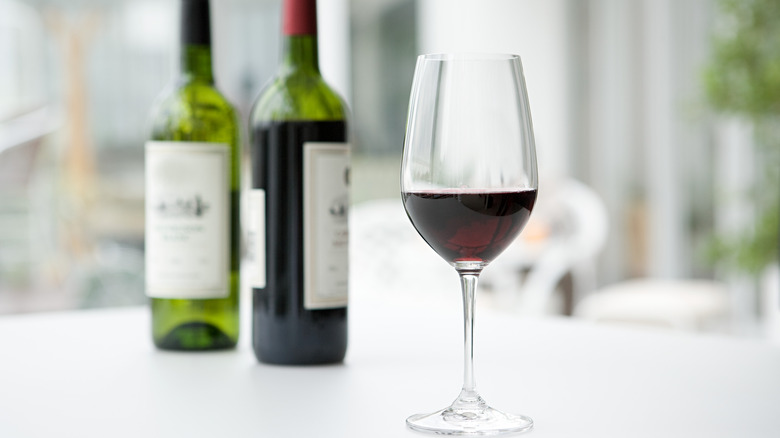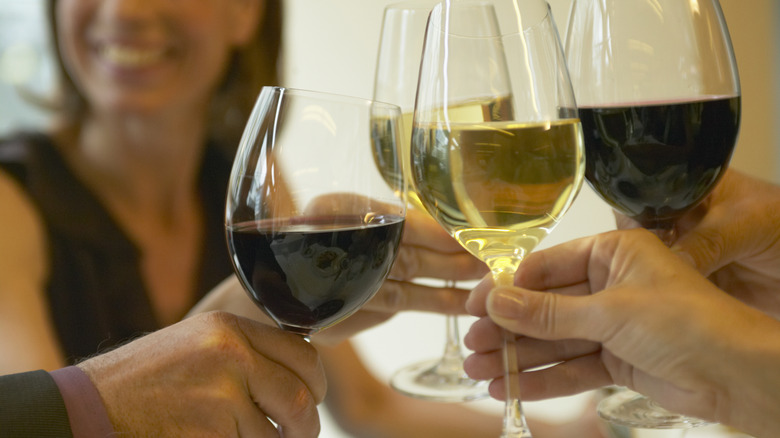The Little-Known Glassware Etiquette Rule To Remember For Fine Dining
Fine dining has evolved so much since it first emerged in 19th century France (per Eater). Gone are the days of confusing table settings with multiple forks, and for the most part dinner jackets and ties are not required in dining rooms except in the most formal of settings, and even then they are usually just a suggestion, like at Le Cirque.
There are plenty of dining etiquette rules that endure, however. For example, most people know that it's good manners to wait until the entire table is served before anyone begins eating and that you should always pass the salt and pepper shakers as a pair. And everyone knows it's not ok to put elbows on the table or to slurp your soup.
Times, they are a changin' though, and fine dining days may be numbered, but that doesn't mean good manners ever go out of style. There are some rules that will always be in good taste, like leaving your napkin on the chair when you get up instead of on the table and tasting your food before adding any condiments. There are some other rules that you might not know, however, that you might want to add to your repertoire so you can be on point at your next outing.
The rules of glassware
Some of the most important rules of table etiquette have to do with glassware. Naturally, you should be serving your wines and cocktails in the proper stemware. A good bartender will make sure your bourbon or brandy is in the correct coupe or snifter, and a sommelier will make sure you have the right red or white glasses, but once they are on the table it's up to you to maintain the proper decorum.
First things first, make sure you're holding your glass correctly. If it's a piece of stemware like a wine glass or cordial, always pick it up and hold it by the stem. They are designed to hold the liquid in your glass away from your hand so that you don't warm up the wine or spirits in the bowl of the glass.
Holding the glass by the stem also prevents you from leaving unsightly fingerprints on the outside. In the same vein, you probably didn't know that it's proper etiquette to drink from the exact same spot for the entire evening. Myka Meier, founder of Beaumont Etiquette and The Plaza Hotel Finishing Program said in an etiquette course for Uber Eats that you want to "avoid that lip ring, whether it's from natural oils or chapsticks or lipstick," (per Food & Wine).
To clink or not to clink
One common ritual is a little controversial when it comes to drinking manners – clinking glasses. The act of tapping glasses together and saying "cheers" before taking a sip has a few probable origins, which date back to ancient Greek and Roman times. First, clinking enhances all five senses by adding sound and bringing everyone's glasses together in camaraderie when having a drink. Clinking is also a little bit superstitious, as it was believed that the ruckus would ward off evil spirits — and if that didn't work then a little wine or beer spilled on the floor might help, according to The Farmer's Almanac.
Some modern etiquette experts say, however, that clinking glasses is poor form (per Reuters). While it might be an ancient ritual, clinking is frowned upon in fine dining because it's rough on fragile glassware, which can cost as much as $40 or $50 each (or more) for high-end stemware according to Well + Good. Clinking is also loud, which while part of the fun is distracting to other diners.
If you're a clinker, however, nobody is probably going to stop you if you're celebrating at a fine dining restaurant. Just try to clink your glasses in the bowl or "bell" part of the glass, where it's the strongest. Don't clink the rims together as the edges are thinner, provoking a higher chance of breaking the glass, not to mention spilling the wine (per Vintage Roots).


